
* During the 1950s, the US Army initiated development of a battlefield surveillance aircraft, which would emerge as the Grumman "OV-1 Mohawk", a twin-turboprop machine that served with distinction with the US Army for several decades. This document provides a history and description of the OV-1.
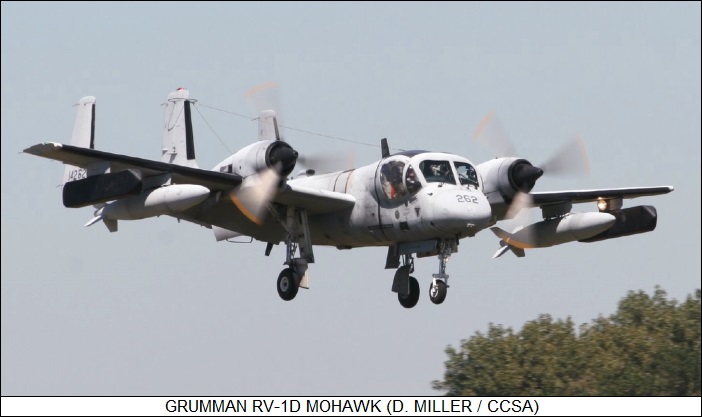
* In late 1954, the US Army issued a requirement for a battlefield surveillance and utility aircraft, and in early 1956, the Army met with representatives of six aircraft manufacturers to consider proposals. The proposals were used to generate a final specification, which was kicked upstairs to the Pentagon for approval in the spring of 1956.
At this point, the political wrangling began. The Department of Defense wanted the Army to talk to the US Air Force (USAF) to ensure there was no duplication of missions between the two services. The US Navy, working on behalf of the Marine Corps, also became involved.
While Army officials haggled with their opposite numbers in the other armed services, in June 1956 the Army came up with a final specification for the new aircraft, indicating that it should have twin turboprop engines for combat survivability; carry a crew of a pilot and observer; be capable of short take-offs and landings on rough airstrips; and be able to fly in bad weather conditions. The Navy also wanted the aircraft to operate from small escort carriers. Although one of the consequences of interservice politics of the time was that the Army was restricted to operating fixed-wing aircraft with an empty weight of less than 2,270 kilograms (5,000 pounds), the limit was waivered in this case.
In March 1957, Grumman Aircraft Corporation was awarded the contract to develop the aircraft, which was given the company designation of "G-134". The contract specified development of nine prototype and evaluation aircraft, with five for the Army to be designated "YAO-1", and four for the Marines to be designated "YOF-1".
The relationship between the services over the G-134 was quarrelsome. The Marines wanted a simple spotter aircraft to replace their old Cessna OE-1 Bird Dogs, and were not interested in the sophisticated sensor payloads that the Army was considering for the G-134. The Marines also wanted the G-134 to have stores pylons to carry weapons, which annoyed the Air Force, which wanted to retain control of the battlefield close-support mission. However, the Navy decided to build a fleet tanker vessel and didn't have the money to buy the Marines a new observation aircraft. The Navy and Marines pulled out of the program in September 1957, much to the relief of the Army. The Army took over the four Marine prototypes; apparently all nine prototypes were assigned the "YAO-1" designation.
* The first Grumman YAO-1 performed its initial flight on 14 April 1959 from the Grumman plant at Bethpage, New York, with Grumman chief test pilot Ralph Donnell at the controls. The flight test program went very smoothly, with few major changes required to the basic design. The aircraft proved to be marvelously agile, with a low stall speed and very good short-field performance.
It was also powerful and fast compared to the piston-engined aircraft previously flown by many Army aviators, and in fact set a number of performance records for its class. The type's high performance would eventually lead to a number of deadly accidents, caused by pilots who became overenthusiastic at the controls. That was not really a fault of the aircraft, which had few handling vices and was extremely strong. Although the YAO-1F was designed for a ten-year service life, fatigue tests demonstrated that it would probably be good for twice that -- a tribute to the tradition of Grumman's "Iron Works" in building very rugged aircraft.
The YAO-1 was named the "Mohawk" after the Army's tradition of naming aircraft after American native tribes. There's an odd little story behind the name selection: the Army originally selected "Mohawk" and asked if the company liked the name; Leroy Grumman suggested "Montauk" instead, after a tribe that was native to Long Island, Grumman's home base. The Army wasn't too particular but the paperwork had gone too far to make the change, and so the Army simply suggested that "Montauk" be reserved for the next aircraft Grumman built for the Army. That name would never be used.
Even before the first flight of the prototype, in March 1959 the Mohawk had been ordered into production as the "AO-1AF". It went into US Army service in Germany in 1961 and in Vietnam in September 1962. In that month, the US military services consolidated their aircraft designation schemes, and the YAO-1 and AO-1AF became the "YOV-1A" and "OV-1A" respectively.
BACK_TO_TOP* The OV-1A carried a KS-61 reconnaissance system built around a KA-30 film camera in a bay in the rear fuselage. The camera could pivot from horizon to horizon and could be set to shoot vertically, 15 degrees off the centerline, or 30 degrees off the centerline. Boxy photoflash flare pods could be fitted above the wing roots to provide a total capacity of 52 flares, which were ejected upward to ensure that the flash was above the camera and stayed out of the field of view. One unusual sensor payload was an AN/ADR-6 radiation detector ("radiac"), fitted in the rear fuselage to allow the aircraft to map radiation on a nuclear battlefield. The detector activated a cockpit alarm if radiation levels were high enough to put the crew at risk. The Mohawk was also fitted with a comprehensive suite of radio and navigation gear, as well as an identification friend or foe (IFF) transponder.
The Mohawk had a bulged cockpit with a snub nose to provide a superlative field of view for its pilot and observer. In principle, both crew had flight controls, but in practice the right-side flight controls usually weren't fitted. Canopy side panels hinged upward to allow entrance and exit from the cockpit, with a boarding step sliding down from each side of the nose below the panels.
The two flight crew sat on armored Martin-Baker Mark 5 ejection seats, which fired through frangible canopy top panels. Ejection seats were adopted because the Mohawk had big props on either side of the cockpit that blocked a conventional bailout, and the Mohawk was intended to fly operationally at low altitudes, meaning ejection seats were the only safe way to get out in any case. It was the first aircraft built specifically for US Army service to have ejection seats. The Mark 5 seats could be fired from zero altitude, but required a minimum flight speed of 185 KPH (115 MPH / 100 KT) to be used safely. Improved Mark 5D seats were later fitted that reduced the minimum safe flight speed to 110 KPH (68 MPH / 60 KT).
The cockpit floor was 6.4-millimeter (1/4-inch) thick Dural (aluminum / copper / magnesium alloy) plate for protection against small-arms fire; the windshield glass was bullet-resistant and 2.5 centimeters (an inch) thick; and the cockpit could be fitted with flak curtains on the forward and rear walls. Heavy-duty windshield wipers were provided to deal with wet weather.
The Mohawk had tricycle landing gear, with the nosewheel retracting backward and the main gear retracting outward into the wings. The gear was hydraulically activated, with a backup pneumatic system. All the gear had single wheels and the nosewheel was steerable. Low-pressure tires were fitted to heavy-duty struts for rough-field operation, and a small tailskid was fitted to protect the rear fuselage during steep short-field take-offs.
The YOV-1As had been fitted with Lycoming T53-L-3 turboprops with 715 kW (960 SHP) each. Initial production batches of the OV-1A featured the nearly identical T53-L-3A engine, but later production had the T53-L-7 with 750 kW (1,005 SHP) each. The Mohawk is said to have been the first fixed-wing aircraft to be fitted with the T53, the engine already having been selected for the Bell UH-1 "Huey" helicopter. The engines were mounted on top of the wings, giving them some protection against ground fire, and "toed out" slightly to improve engine-out handling. The exhausts were on top of the nacelles, which would later give the aircraft a degree of protection against man-portable heat-seeking surface-to-air missiles (SAM). The engines were not "handed", simplifying maintenance and support at some (apparently trivial) cost in maneuverability. They drove three-bladed Hamilton Standard propellers with a diameter of 3.05 meters (10 feet). The propellers were fully reversible to reduce landing roll.
The wings had a 6.5 degree dihedral, and were fitted with large-area flaps and full-span leading-edge slats to reduce take-off roll. Take-off run was 358 meters (1,175 feet), in contrast to 1,160 meters (3,800 feet) for a Lockheed C-130 Hercules. Although an early G-134 mockup featured a high tee tail, a distinctive triple-fin tail scheme was adopted instead because it provided better engine-out handling.
A hydraulically-operated dive brake was fitted to each side of the rear fuselage behind the wing. Internal fuel capacity was 1,125 liters (297 US gallons) in a single self-sealing fuel tank in the fuselage above the wings, giving the Mohawk an endurance of 2 hours 20 minutes. The tank was part of the aircraft's frame, and it was built very strong, with panels from it subjected to machine-gun fire in tests to ensure survivability.
In operation the Mohawk generally carried a 567-liter (150 US gallon) fuel tank under each wing, giving the aircraft an endurance of 4 hours 30 minutes. Double-size external tanks could be used for ferry flights, but these were rarely used. The OV-1A was designed to be fitted with up to six underwing pylons, as per Marine requirements, but only two were fitted initially in production, to allow it to carry the two external tanks. The aircraft was designed for easy maintenance, with direct access to the majority of systems through panels that could be reached without ladders or work stands. The avionics bays were in the fuselage beneath the wings.
There were minor differences from the YOV-1A prototypes and the OV-1A, such as an improved nosegear strut; deletion of "eyebrow" windows above the windscreen and deletion of small windows behind cockpit side transparencies; addition of a hinged nose cone; and fit of black rubber pneumatic de-icing boots on the leading edges of the flight surfaces. A total of 64 OV-1As was built, with initial deliveries in early 1960, and final deliveries in early 1965.
BACK_TO_TOP* The OV-1A was actually produced more or less in parallel with two other variants, the "OV-1B" and the "OV-1C" (originally "AO-1BF" and "AO-1CF" respectively). Essentially, at the outset there were three specialized Mohawk variants: the OV-1A for daylight observation; the OV-1B for radar observation; and the OV-1C for infrared observation.
The prototype OV-1B was modified from one of the nine YOV-1As and performed its first flight on 13 September 1960. The primary enhancement was the addition of the big Motorola "AN/APS-94 Side Looking Airborne Radar (SLAR)", with the radar antenna in a 5.5-meter (18-foot) long, boxy, yaw-stabilized fiberglass pod slung under the right fuselage. The OV-1B retained the optical cameras.
The AN/APS-94 SLAR provided an imaging reconnaissance capability in day or night, in any weather. It shot radar signals to either or both sides of the aircraft and recorded the echoes onto photographic film strips, which were automatically developed in flight. A sensor station was installed to allow the operator in the right-hand seat to monitor and control the SLAR. The SLAR also had a "moving target indicator (MTI)" capability to highlight moving vehicles on the imagery. An autopilot and Doppler navigation radar were added to help the aircraft fly nice neat radar mapping patterns, and a VHF data link was installed to allow real-time relay of SLAR data to a ground station. This being the days before digital sensor systems, apparently the datalink simply relayed the analog radar returns to a ground station to be stored on film or by other analog means.
Initially, the airframe configuration of the OV-1B was much the same as that of the OV-1A. However, the leading-edge slats (which had not proven very effective) and airbrakes were deleted in later production batches, and the wingspan was stretched by 1.79 meters (5 feet 10 inches) to help lift the SLAR. Most of the early machines were refitted with the wider-span wing. As with the OV-1A, initial OV-1B production featured T53-L-3A engines, while later production featured T53-L-7 engines. Some OV-1Bs were refitted with Lycoming T53-L-15 turboprops with 860 kW (1,150 SHP) each. 101 OV-1Bs were built, with initial deliveries in the summer of 1960 and final deliveries in the spring of 1965.
* Initial OV-1C production examples simply amounted to an OV-1A with an "AN/UAS-4 Red Haze" infrared (IR) sensor system in addition to its optical cameras. The AN/UAS-4 could spot fires, hot ground vehicle engines, and other evidence of enemy activities at night, in poor weather, or under jungle canopy. The sensor was originally mounted in the rear fuselage, but was later put in a blister on the belly just behind the wing, along with a panoramic camera and an anti-collision light.
As with the OV-1B, the operator was provided with a sensor control station, and the IR data was recorded on film strips. The AN/UAS-4 was later replaced with the more sensitive "AN/UAS-14" sensor system, which included a data link to allow reconnaissance data to be transferred to battlefield commanders in real time. The greater sensitivity of the improved sensor allowed operations at higher altitudes, giving more protection against small-arms fire. The OV-1C was also said to have featured a chute to allow the flightcrew to drop messages to field units; it is unclear if other Mohawk variants had this little feature.
Also as with the OV-1B, initial OV-1Cs had airframes similar to those of the OV-1A, with airbrakes, leading-edge slats, and short wings, as well as T53-L-3A engines; and were enhanced in production to long wings with the airbrakes and slats deleted, plus T53-L-15 engines. The OV-1C was, however, the first Mohawk variant to be built with air conditioning. The late production machines with the T53-L-15 engines also had strip ("tape") style dashboard indicators replacing the classic dial indicators; these machines were sometimes called "Super Cs". Late production OV-1Cs had a nose panel for a KA-60 panoramic camera that could take 180-degree pictures in front of the aircraft, with this feature also retrofitted to older aircraft. 169 OV-1Cs were built, with delivery from early 1961 to late 1969. More OV-1Cs were built than any other Mohawk variant.
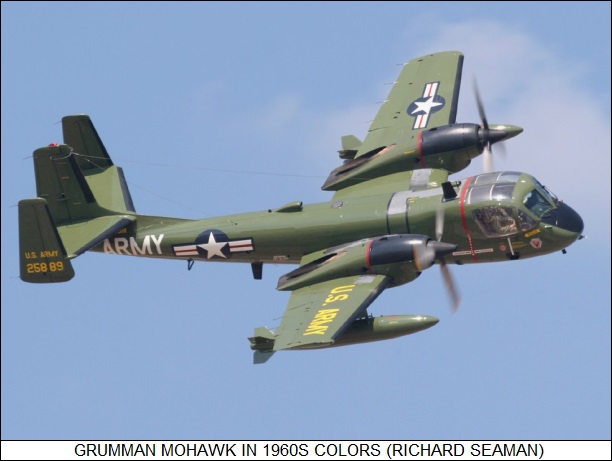
* Early on, there were a number of interesting experiments with the Mohawk. One OV-1B was experimentally fitted with a midair refueling probe for ferry flights, but this scheme was not adopted. Snow ski landing gear was successfully evaluated for the Mohawk, but it was never used operationally. There was even a scheme to fit the Mohawk with water ski landing gear, in response to a Marine request, to allow it to land on calm waters and taxi up to a beach. The concept was successfully tested, but it wasn't used operationally; apparently pilots were not comfortable with the idea of setting an aircraft down on water with the prospect of sinking if taxi speed fell too low -- though of course the adventurous might have thought water-skiing an aircraft would be good fun.
In 1967, Grumman modified two OV-1Bs and two OV-1Cs under the "Southeast Asia Mohawk Requirement (SEAMORE)" program with a substantially improved avionics suite, including improved sensors, navigation and targeting systems, and a radar warning receiver (RWR). They were flown over Southeast Asia during the last years of the Vietnam War, with one lost in action. The SEAMORE program remains a bit mysterious.
BACK_TO_TOP* The Mohawk had originally been designed to carry a light warload, and the US Army didn't see any reason not to make use of the capability in Vietnam. The Army had Grumman refit a number of OV-1As (including two of the YOV-1A prototypes) and OV-1Cs with all six stores pylons and install a Mark 20 fixed reticule gunsight in the cockpit for the pilot. These modified aircraft were redesignated "JOV-1A" and "JOV-1C". In principle, they could carry:
Other stores included flares pods, smoke generators, and the M4A supply container. It is unclear if all these stores were actually qualified, and unlikely that all of them were actually carried in service. It is particularly hard to believe Sidewinders were ever carried operationally, or that the Army even had them in inventory.
The actual number of JOV-1A/C conversions is unclear: some sources hint that a number of Mohawks were converted to an armed configuration and not redesignated, and that the JOV-1A/C designation was only given to armed machines with dual controls. A total of 59 JOV-1A/Cs is cited but is a bit untrustworthy.
Air Force brass saw the JOV-1A/C as an Army attempt to perform the close-support mission, which they insisted was their job and objected loudly. The Army formally changed the name back to OV-1A/C, though they did not remove the pylons or the gunsight. Many of these aircraft would serve in Vietnam, often carrying smoke rockets, plus sometimes more lethal stores for "self-defense". The Air Force remained very touchy about the issue, even demanding that Grumman get rid of company brochures that highlighted the Mohawk's attack capability. In 1965, the Pentagon handed down a directive dictating that the Army would not operate armed fixed-wing aircraft.
BACK_TO_TOP* Having to support three different versions of the Mohawk was troublesome, and so it was logical to develop one Mohawk version to replace all three variants. The result was the definitive "OV-1D".
The OV-1D had the wider wingspan of the OV-1B; the airbrakes and slats were deleted. It featured T53-L-701 turboprops with 1,045 kW (1,400 SHP) each and improved propellers; louvered exhaust suppressors could be fitted to help protect the aircraft from heat-seeking missiles. The airframe was reinforced to handle greater weights.
The OV-1D featured three quick-access compartments that allowed an improved AN/AUS-24 IR sensor system and the AN/APS-94 SLAR systems to be easily swapped out. The canoe pod for the SLAR could be bolted on or removed quickly, with a full configuration change taking no more than an hour. Early OV-1Ds featured the AN/APS-94D SLAR, while late machines had the AN/APS-94F SLAR. Both sensor systems used the same cockpit display and control panel.
Camera systems included the standard panoramic camera in the fuselage, the panoramic camera in the nose added to late-production OV-1Cs, and a new KA-76 "serial frame" camera under the fuselage to provide along-track imagery. Night imagery could be obtained using an electronic photoflash unit carried in a wing pod and driven by a nose windmill on the pod. Flares had proven troublesome to handle in the field, with improperly loaded flares said to have caused accidents in which the entire flare load lit off in the launcher pack. The photoflash pod was also carried by older Mohawk variants.
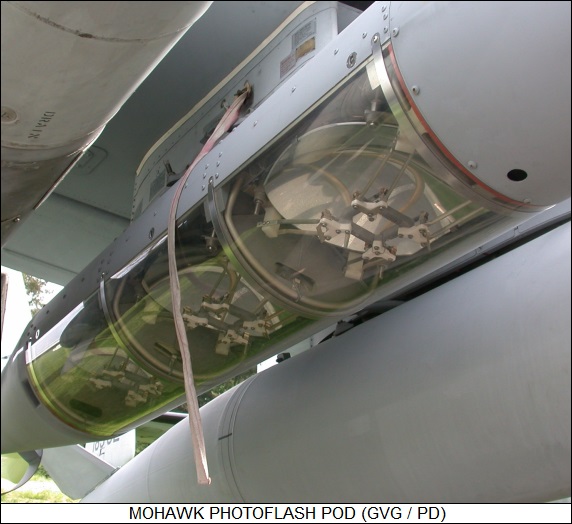
Avionics improvements were added as well, particularly in the form of the "AN/ASN-86 inertial navigation system", which provided accurate all-weather flight guidance. In addition, late production OV-1Ds had a very capable defensive countermeasures suite, including:
Early machines had a subset of the countermeasures suite, in particular relying on jamming pods carried on wing pylons.
___________________________________________________________________
GRUMMAN OV-1D MOHAWK:
___________________________________________________________________
wingspan:
14.63 meters (48 feet)
wing area:
33.44 sq_meters (360 sq_feet)
length (no SLAR):
12.5 meters (41 feet)
length (with SLAR):
13.69 meters (44 feet 11 inches)
height:
3.86 meters (12 feet 8 inches)
empty weight:
5,330 kilograms (11,760 pounds)
max loaded weight:
8,215 kilograms (18,110 pounds)
maximum speed:
490 KPH (305 MPH / 265 KT)
service ceiling:
7,620 meters (25,000 feet)
range:
1,520 kilometers (945 MI / 822 NMI)
___________________________________________________________________
Four OV-1Cs were converted to the "YOV-1D" configuration for evaluation in 1968, with 37 new-production machines delivered in 1969 and 1970. 61 OV-1Cs were then upgraded to the OV-1D configuration beginning in 1973, with the last delivered in 1981; followed by the upgrade of 17 OV-1Bs to OV-1D configuration, with deliveries from 1982 into early 1987. That gave a 37 new-build OV-1Ds and 82 upgrades to OV-1Ds (including the four YOU-1Ds), for a total of 119 OV-1Ds in all.
* Apparently the Army had some misgivings about the Mohawk early on, since the fussing over the type with the Marines and the Navy had led to an aircraft that was more complicated and expensive than the Army had originally wanted. However, once the machine went into combat, the Army decided they'd made the right choice after all.
The Mohawk gave outstanding service in the Vietnam War, providing high-quality intelligence on enemy positions and activities. It operated over South Vietnam, Laos, Cambodia, and occasionally even North Vietnam. The Mohawk often flew cooperative missions with US Air Force, Navy, or Marine forces. The Mohawk's ability to operate from forward airstrips and provide real-time intelligence was a great benefit to Army field commanders, permitting immediate artillery or air strikes to be called in on enemy troop movements. It was also occasionally used to parachute supply canisters, carried on underwing pylons, to combat units in isolated locations.
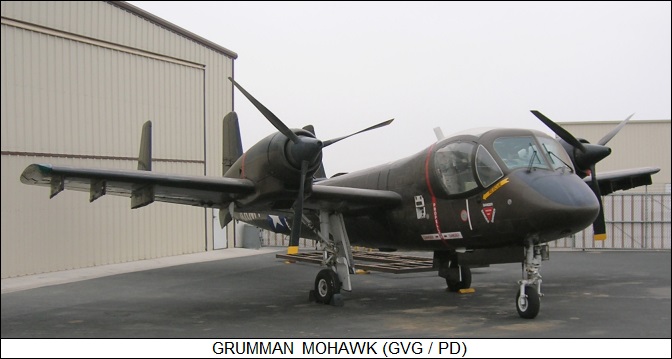
The Mohawk's agility, ability to fly low, and its relatively quiet turboprop engines allowed it to sneak up on the enemy unannounced, and the enemy is said to have referred to it as the "Whispering Death" -- though that sounds like marketing hype. Its combat survivability was very good, and its reliability and maintainability were outstanding, with the highest availability rate of any Army aircraft.
The Mohawk's lack of serious offensive armament was troublesome to field commanders, however, because in many cases the Mohawks found concentrations of enemy troops who would be gone by the time strikes could be called in. The field commanders argued at length against the Air Force restriction on armed Army fixed-wing aircraft, but got nowhere. In many cases, the Mohawks were armed anyway, presumably with 70-millimeter unguided rocket pods, a common store on Army helicopter gunships.
In 1966, one Mohawk reputedly shot down a North Vietnamese MiG-17 fighter with unguided rockets. The North Vietnamese pilot made a pass at one of a pair of Mohawks, the other loosed a salvo of rockets at the fighter, and to the surprise of all, managed to hit the MiG. However, one Mohawk was shot down by a North Vietnamese MiG in 1969, evening the score. This was the only Army fixed-wing aircraft loss in air-to-air combat during the war.
A total of 27 Mohawks was lost in combat action in Vietnam, including one destroyed on the ground, and a further 36 were lost in accidents. There is a story that the crew of one shot-up Mohawk ejected, and the aircraft then obligingly crashed into a scrapyard. In 1972, Mohawks began to be transferred to the Army National Guard, but the type still remained in first-line regular Army service for two decades longer.
BACK_TO_TOP* Several Mohawk modifications also saw service. Since it was designed for the reconnaissance role and could carry sophisticated sensors, it was well suited for modification to the "electronic intelligence (ELINT)" role. The exact history of the use of the Mohawk as an ELINT platform is somewhat confusing, with different sources giving different stories. In general, it can be said:
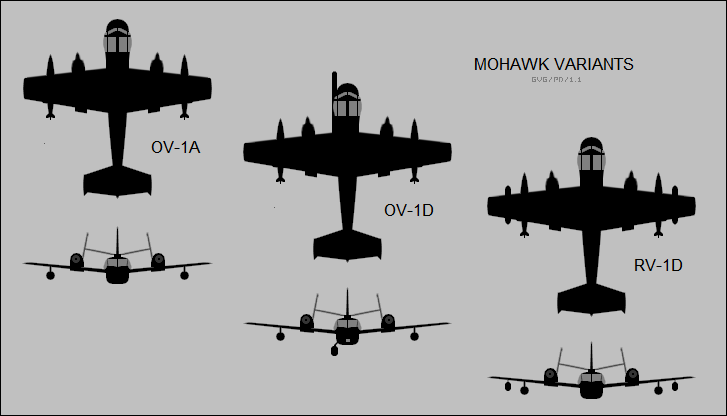
* In 1986, the Army initiated a service update program for the Mohawk. One OV-1D was modified with a "glass cockpit", Global Positioning System (GPS) navigation satellite receiver, and other modernized kit, with this machine flying in 1988. Although the Army planned to update the entire fleet to the same configuration, the decision was made to phase out the Mohawk, and that was the end of it.
* There were a number of proposals for Mohawk variants that never happened. In 1960, Grumman proposed an "AO-1EF", with the forward fuselage stretched 71 centimeters (28 inches) to accommodate a third seat for a sensor systems operator. The additional space could also be used for cargo. It was to feature fixed seats, replacing the ejection seats, and had an entry door behind the propeller arc. The AO-1EF never went beyond a cockpit mockup.
There were other proposals with different engine fits, including one with T55 turboprops; one with an auxiliary J85 turbojet in the fuselage; and one with twin J85s driving ducted fans. One particularly adventurous proposal was the "Model 134E" Mohawk, which was to be a "tiltwing" vertical take-off aircraft with four turboprops, a horizontal tail rotor, and a stretched fuselage to allow it to carry cargo or 11 troops. None of these projects went beyond the paper stage.
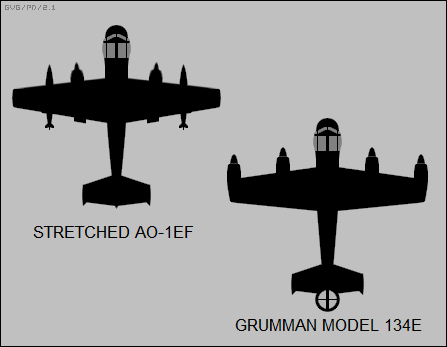
Grumman also came up with a design for an extensively modified Mohawk "Model 134R", with an armored tandem cockpit and built-in gun armament, as a "counter insurgency (COIN)" aircraft for the Army's "Light Armed Reconnaissance Aircraft (LARA)" competition, but lost to Rockwell International's OV-10A Bronco. The Marines would adopt the Bronco for the spotting role as a replacement for their Bird Dogs. The Philippines later came up with a request for a COIN aircraft, and Grumman responded with a more conservative proposal to update 20 OV-1Bs to a fully armed standard, while Rockwell proposed the OV-10A. However, the Philippine government came up short on money and the deal fell through, though the Philippines would later acquire a batch of refurbished Broncos.
BACK_TO_TOP* In the post-Vietnam era, the Mohawk generally operated with the US Army in Germany and South Korea, though it did see limited service in Central America as well. Its final combat service was in 1991 during Operation DESERT STORM, the campaign to evict the Iraqis from Kuwait. The last Mohawks in US Army service were withdrawn in the mid-1990s. These aircraft had been used to observe North Korean military activities along the demilitarized zone, and were replaced by De Havilland Canada DASH-7 / Airborne Reconnaissance Low aircraft, discussed in the next chapter.
* The Mohawk was also used by civilian organizations. Army Mohawks were flown for the US Forest Service to spot forest fires and obtain survey data on the spread of tree diseases. In 1980, Oregon Army National Guard Mohawks flew surveillance missions to monitor the eruption of Mount Saint Helens in southwestern Washington state. Army Mohawks also assisted the US Coast Guard, the Civil Air Patrol, and state and local public-safety organizations in search and rescue operations, with the SLAR and IR sensors proving particularly useful in hunting for crashed aircraft in mountainous terrain.
In the early 1970s, the US Geological Survey (USGS) performed large-area mapping missions with an OV-1B fitted with a modified SLAR. The flights were part of a study to determine state water resources, and the aircraft was later used to perform survey missions in Alaska. During the Alaska missions, the aircraft carried emergency flotation gear on the underwing pylons to allow the flightcrew to ditch at sea in an emergency, since ejecting into the frigid Arctic environment would have given little chance of survival.
The US Environmental Protection Agency (EPA) used an OV-1B and an OV-1C to perform environmental surveys of the areas around nuclear power plants in the early 1970s, and a civilian engineering firm working for the Atomic Energy Commission also obtained an OV-1C to monitor underground atomic tests during 1972. The US National Aeronautics & Space Administration (NASA) used a few Mohawks for aviation technology experiments, including one that was fitted with a small turbojet engine for noise tests.
In a particularly interesting application, in 1973 the US Customs Service received four Army surplus OV-1C Mohawks, along with two ex-Navy Grumman S-2 Tracker ocean patrol aircraft, to hunt drug traffickers. The Mohawks were fitted with a Texas Instruments forward-looking infrared (FLIR) camera in a turret under an extended nose. Since the Customs OV-1Cs were sometimes fired on by drug runners there was some thought of arming the Mohawks so they could shoot back -- but despite the fact that Customs officers often carry some impressive personal firepower, formally arming a Customs aircraft was judged against the rules. They were originally flown in Army colors, but then acquired a much spiffier white / dark-blue color scheme. The Mohawks were phased out in favor of more modern aircraft in 1986.
A few Mohawks ended up in Navy service, with the Navy performing the weapons qualifications for the JOV-1A/C, and later served at the Test Pilot Training School at Patuxent River in Maryland, which necessarily featured a lot of aircraft that nobody would have ever visualized as wearing Navy blue. At least three Mohawks ended up in private hands, and occasionally starred in TV series such as AIRWOLF, with the type's unusual looks making it well suited to playing the "black hat".
* The Mohawk's foreign service was limited. Both Germany and France were interested in the Mohawk and performed flight evaluations with it in 1962 and 1963. The French Breguet firm actually obtained a license from Grumman to build it, fitted with more powerful de Havilland Gnome turboprops, but the deal fell through. The first Mohawks in foreign service were actually two OV-1Ds were transferred to Israel in 1974 to support monitoring of the Yom Kippur War cease-fire, to be returned to the US in 1984 and refurbished.
23 US Army surplus Mohawks were provided to Argentina in the early 1990s; the Argentines wanted to obtain 11 more, but didn't have the money. At last report, ten of these aircraft were still in service, the rest having either been lost or used as spares hulks. The Argentines evaluated the type with a range of weapons, including locally-built cluster munitions.
A total of 380 Mohawks was produced. A list of variants follows:
* I actually saw some of the Oregon National Guard Mohawks in the air in the early 1980s. Though I've seen others on static display, that was the only time I had the privilege of seeing Mohawks in flight.
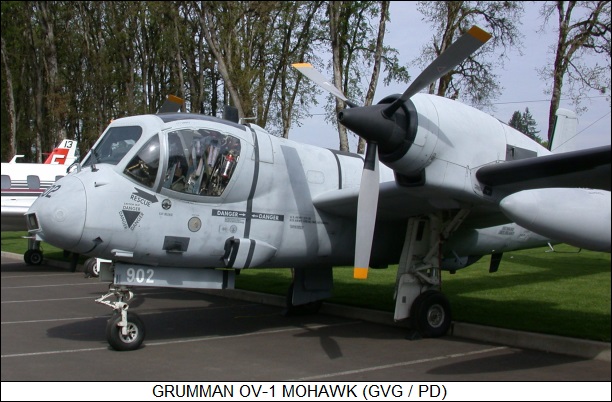
* Sources include:
* Revision history:
v1.0 / 01 feb 01 v2.0.0 / 01 nov 10 / General update. v2.0.1 / 01 sep 12 / Review & polish. v2.0.2 / 01 aug 14 / Review & polish. v2.0.3 / 01 jul 16 / Review & polish. v2.0.4 / 01 jun 18 / Review & polish. v2.0.5 / 01 apr 20 / Review & polish. v2.0.6 / 01 feb 22 / Review & polish. v2.0.7 / 01 jan 24 / Review & polish. (+)
The original v1.0 document was rolled into a comprehensive survey of battlefield reconnaissance aircraft in April 2001. In 2010, I decided the survey was clumsy and too hard to maintain, so I broke it down again, restoring the stand-alone Mohawk document with revcode v2.0.0.
BACK_TO_TOP